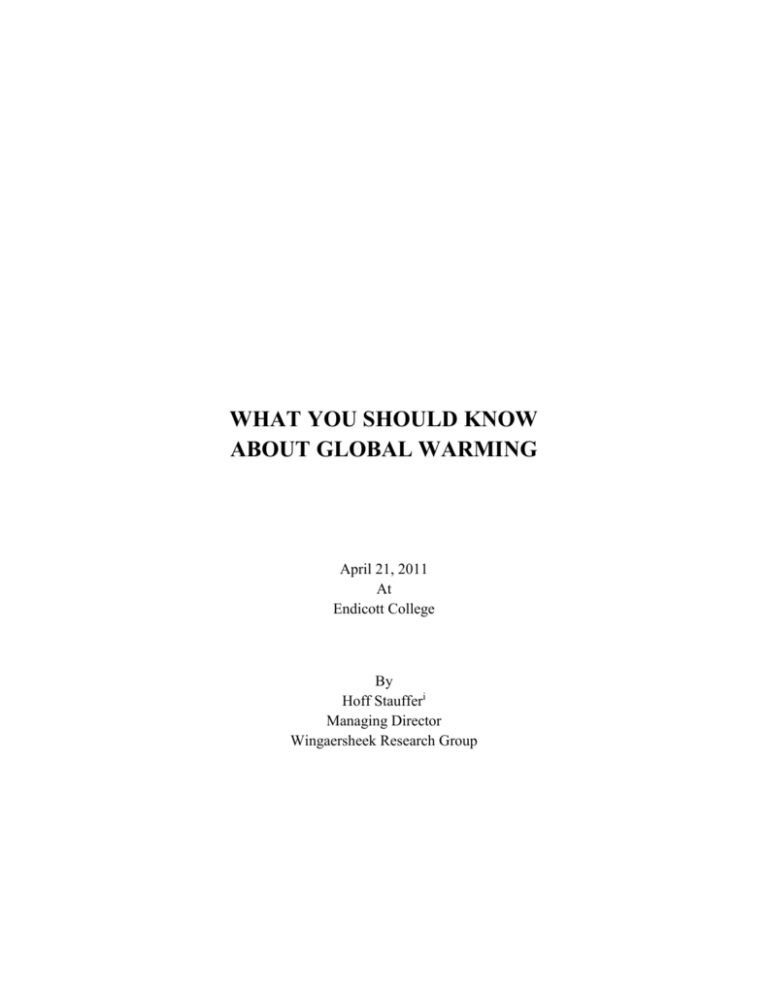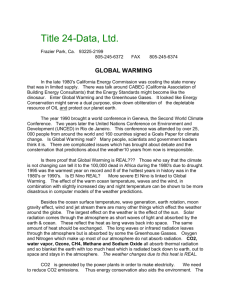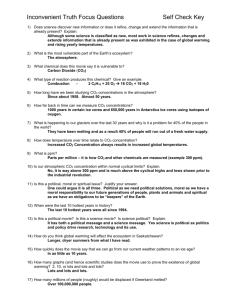What You Should Know about Global Warming, April, 2011
advertisement

WHAT YOU SHOULD KNOW ABOUT GLOBAL WARMING April 21, 2011 At Endicott College By Hoff Staufferi Managing Director Wingaersheek Research Group What You Should Know About Global Warming April 21, 2011 Global warming is one of the major issues of our time, but a lot of people are confused by misinformation on this topic. In this paper I share what I believe is the minimum that a responsible person should want to understand about global warming: (1) the problem is real. (2) There are technical options for solving the problem at reasonable costs. (3) But progress on adopting these options has been inhibited by politics. I discuss each of these three points below. The Problem Is Real The fundamental science is actually quite simple. Carbon dioxide (CO2) concentrations in the atmosphere have been increasing. Man-made emissions of CO2 have been increasing. These man-made emissions of CO2 (and other greenhouse gases) are increasing the concentration of CO2 in the atmosphere. Higher atmospheric concentrations of CO2 (and other greenhouse gases) result in global warming. The average temperature of the earth has increased already, and further increases are imminent. To make matters worse, there are feedback mechanisms that exacerbate the problem. Melting ice caps means that the darker water absorbs more of the sun’s energy. Defrosting frozen tundra releases methane which is a more potent greenhouse gas than CO2. Both of these feedbacks (and others) accelerate global warming. Those that would argue otherwise probably fall into one of three categories: 1. They have not done their homework. They do not understand the science. They do not know the facts. They are uninformed. 2. Those that prefer to ignore the problem, because they do not like the solutions. These resemble the proverbial ostrich with its head in the sand. 3. Those that sell out for short-term selfish reasons. They think they can make a better living in the short term by denying the problem and delaying the solutions. Some of corporate America falls into this category. These people may deserve our compassion but not our respect. Global warming will produce winners and losers, but probably more losers. Winners would include (a) North Shore sailors who enjoy a longer sailing season and (b) farmers in such places as Canada and northern Europe and Asia due to a longer growing season. Losers would include: (a) low coastal areas and island nations that will be inundated by rising sea levels as the ice caps and glaciers melt, (b) polar bears that will have no ice to live on, (c) blue fin tuna whose food supply is being reduced because the warmer water inflows into the Gulf of Maine are being replaced by colder water inflows from the melting ice cap, (d) the US southwest, northern Africa, and much of Asia which will get less rain fall, and (e) those affected by more severe weather, including hurricanes, worldwide. Man has created this problem, and most of mankind will not like the effects. 2 What You Should Know About Global Warming April 21, 2011 There Are Technical Options That Could Solve the Problem at Modest Costs There are a variety of technical options that could be adopted to solve the problem. These can be grouped into three broad categories: 1. Efficiency in a. Transportation. Auto fuel economy can be easily doubled in the short-run, with greater gains in the long-run. b. Buildings. 40% of our energy use is in buildings. Massive gains are possible in the short-run and more thereafter. I was able to reduce energy use in our home by 80% (with a return on investment exceeding of 10%) with: insulation, air-sealing, better windows, efficient appliances (including lighting, refrigeration, furnaces, and water heaters), solar hot water, and solar photo voltaic panels. c. Industry. Options include more efficient lighting and electric motors, process change, waste heat recovery, and cogeneration. 2. Natural gas is a transition fuel, substituting for dirtier oil in transportation and heating and even dirtier coal in power generation, until gas itself is replaced by clean fuels.ii 3. Clean fuels in the short and longer run, including solar, wind, biomass, safe nuclear power, and clean coal. Together these can solve the problem (without better options yet to be discovered). They can reduce man-made emissions enough that atmospheric concentrations of greenhouse gases will stop increasing and start decreasing. The total costs of these solutions would be less than 2% of world GDP. Progress Has Been Inhibited By Politics Actually, we are doing a lot already, including (a) new efficiency standards for auto fuel economy and appliances, (b) more stringent building codes for new buildings, (c) programs to retrofit existing buildings (and MA has one of the best), (d) requirements for utilities to employ clean fuels, and (e) requirements for blending biofuels into gasoline. Also, ad hoc steps by the Green community have been remarkably effective in stopping new coal-fired power plants in the US, although not in China. But we should be doing much more. We need a standard requiring all new coal-fired power plants to remove at least 90% of the CO2. We need a mandatory requirement age for existing coal-fired power plants. They must retire by a certain age or become as clean as a new plant. Ultimately, we need a standard requiring all new gas-fired plants to remove at least 90% of the CO2. 3 What You Should Know About Global Warming April 21, 2011 Taken together these requirements would unleash market forces to develop clean options. EPA is attempting to do these things under current law, and that is precisely what the Tea-Party-led Republicans are trying to stop. Why are we not doing more? One reason is the Tea-Party-led Republicans who deny the problem and do not like the solutions, which require government intervention. Another reason is both Republicans and Democrats who fear their constituents (e.g., coal miners) would be losers. A third reason is the Green community, who made egregious mistakes. The Greens became addicted to cap and trade.iii Cap and trade could work, but it would be very complicated and would result in massive wealth transfers from consumers to government and to existing green generators (particularly existing nuclear). There are other policy options, such as straight-forward regulation, that would achieve similar effects and would be easier to design without major and/or unanticipated disruptions. But the Greens insisted on cap and trade and ultimately got nothing. It was a high risk bet that lost, when there were much lower-risk options that would have been nearly as good. The best opportunity ever – in the beginning of the Obama administration - to enact meaningful legislation to mitigate global warming was squandered. What do we do now? Greens must be reasonable, come out of their ivory towers, and deal with legitimate concerns, such as job losses and wealth transfers. Potential losers should look for options that minimize the disruption. It makes sense to want to protect the jobs of existing coal miners, but it makes little sense to protect the jobs of future miners. Future would-be miners can find better jobs, such as green jobs. Tea-party folks should become familiar with the science and design policy options that will solve the problem while simultaneously protecting jobs and individual liberties. Global warming is not an impossible problem. Options exist that are technically feasible and economically viable. Even global warming politics need not be intractable. We must find the common ground. i For more information on Hoff Stauffer and his work, please see www.wingrg.com This assumes natural gas recovery is done properly, without groundwater contamination or excessive leakage into the atmosphere. iii Cap and trade is a policy option where total emissions would be capped (with the cap decreasing over time) and emitters would be required to purchase allowances to emit, where the sum of the available allowances is equal to the cap. ii 4








